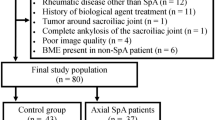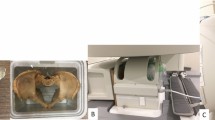Abstract
Objective
To evaluate the reproducibility of T2 relaxation time measurements of the sacroiliac joints at 1.5 T.
Materials and methods
Healthy volunteers underwent an oblique axial multislice multiecho spin-echo sequence of the sacroiliac joints at 1.5 T. Regions of interest were manually drawn using a dedicated software by two musculoskeletal radiologists to include the cartilaginous part of the sacroiliac joints. A senior radiologist performed the measurement twice, while a resident measured once. Intra- and inter-observer reproducibility was tested using the Bland-Altman method. Association between sex and T2 relaxation times was tested using the Mann-Whitney U test. Correlation between T2 relaxation times and body mass index (BMI) was tested using the Spearman’s rho.
Results
Eighty sacroiliac joints of 40 subjects (mean age: 28 ± 4.8 years, range: 20–43; mean BMI: 23.3 ± 3.1, range: 18.9–30) were imaged. The mean T2 values obtained by the senior radiologist in the first series of measurements were 42 ± 4.4 ms, whereas in the second series were 40.7 ± 4.5 ms. The mean T2 values obtained by the radiology resident were 41.1 ± 4.2 ms. Intra-observer reproducibility was 88% (coefficient of repeatability = 3.8; bias = 1.28; p < .001), while inter-observer reproducibility was 86% (4.7; −.88; p < .001). There was significant association between sex and T2 relaxation times (p = .024) and significant inverse correlation between T2 relaxation times and BMI (r = −.340, p = .002).
Conclusion
The assessment of T2 relaxation time measurements of sacroiliac joints seems to be highly reproducible at 1.5 T. Further studies could investigate the potential clinical application of this tool in the sacroiliac joints.




Similar content being viewed by others
References
Hafezi-Nejad N, Zikria B, Eng J, Carrino JA, Demehri S. Predictive value of semi-quantitative MRI-based scoring systems for future knee replacement: data from the osteoarthritis initiative. Skelet Radiol. 2015;44:1655–62.
Albano D, Martinelli N, Bianchi A, Messina C, Malerba F, Sconfienza LM. Clinical and imaging outcome of osteochondral lesions of the talus treated using autologous matrix induced chondrogenesis technique with a biomimetic scaffold. BMC Musculoskelet Disord. 2017;18:306.
Quirbach S, Trattnig S, Marlovits S, et al. Initial results of in vivo high-resolution morphological and biochemical cartilage imaging of patients after matrix-associated autologous chondrocyte transplantation (MACT) of the ankle. Skelet Radiol. 2009;38:751–60.
Albano D, Martinelli N, Bianchi A, Giacalone A, Sconfienza LM. Evaluation of reproducibility of the MOCART score in patients with osteochondral lesions of the talus repaired using the autologous matrix-induced chondrogenesis technique. Radiol Med. 2017;122:909–17.
Apprich S, Welsch GH, Mamisch TC, et al. Detection of degenerative cartilage disease: comparison of high-resolution morphological MR and quantitative T2 mapping at 3.0 Tesla. Osteoarthr Cartil. 2010;18:1211–7.
Kim T, Min BH, Yoon SH, Kim H, Park S, Lee HY, et al. An in vitro comparative study of T2 and T2* mappings of human articular cartilage at 3-Tesla MRI using histology as the standard of reference. Skelet Radiol. 2014;43:947–54.
David-Vaudey E, Ghosh S, Ries M, et al. T2 relaxation time measurements in osteoarthritis. Magn Reson Imaging. 2004;22:673–82.
Dunn TC, Lu Y, Jin H, Ries MD, Majumdar S. T2 relaxation time of cartilage at MR imaging: comparison with severity of knee osteoarthritis. Radiology. 2004;232:592–8.
Lee S, Yoon YC, Kim JH. T2 mapping of the articular cartilage in the ankle: correlation to the status of anterior talofibular ligament. Clin Radiol. 2013;68:e355–61.
Watanabe A, Boesch C, Siebenrock K, Obata T, Anderson SE. T2 mapping of hip articular cartilage in healthy volunteers at 3T: a study of topographic variation. J Magn Reson Imaging. 2007;26:165–71.
Maizlin ZV, Clement JJ, Patola WB, et al. T2 mapping of articular cartilage of glenohumeral joint with routine MRI correlation: initial experience. HSS J. 2009;5:61–6.
Marzo-Ortega H, McGonagle D, Bennett AN. Magnetic resonance imaging in spondyloarthritis. Curr Opin Rheumatol. 2010;22:381–7.
Lefebvre G, Bergère A, El Rafei M, Duhamel A, Teixeira P, Cotten A. T2 mapping of the sacroiliac joints with 3-T MRI: a preliminary study. AJR Am J Roentgenol. 2017;209:389–94.
Pan J, Pialat J-B, Joseph T, et al. Knee cartilage T2 characteristics and evolution in relation to morphologic abnormalities detected at 3-T MR imaging: a longitudinal study of the normal control cohort from the osteoarthritis initiative. Radiology. 2011;261:507–15.
Larbre JP, Da Silva JA, Moore AR, James IT, Scott DL, Willoughby DA. Cartilage contribution to gender differences in joint disease progression. A study with rat articular cartilage. Clin Exp Rheumatol. 1994;12:401–8.
Felson D. Epidemiology of osteoarthritis. In: Brandt KD, Doherty M, Lohmander LS, editors. Osteoarthritis. New York: Oxford University Press; 1998. p. 13–22.
Felson DT, Naimark A, Anderson J, Kazis L, Castelli W, Meenan RF. The prevalence of knee osteoarthritis in the elderly. The Framingham osteoarthritis study. Arthritis Rheum. 1987;30:914–8.
Mosher TJ, Collins CM, Smith HE, et al. Effect of gender on in vivo cartilage magnetic resonance imaging T2 mapping. J Magn Reson Imaging. 2004;19:323–8.
Mosher TJ, Liu Y, Yang QX, et al. Age dependency of cartilage magnetic resonance imaging T2 relaxation times in asymptomatic women. Arthritis Rheum. 2004;50:2820–8.
Lusse S, Claassen H, Gehrke T, et al. Evaluation of water content by spatially resolved transverse relaxation times of human articular cartilage. Magn Reson Imaging. 2000;18:423–30.
Baum T, Joseph GB, Nardo L, et al. MRI-based knee cartilage T2 measurements and focal knee lesions correlate with BMI - 36 month follow-up data from the osteoarthritis initiative. Arthritis Care Res. 2013;65:23–33.
Doniselli FM, Albano D, Chianca V, Cimmino MA, Sconfienza LM. Gadolinium accumulation after contrast-enhanced magnetic resonance imaging: what rheumatologists should know. Clin Rheumatol. 2017;36:977–80.
Savarino E, Chianca V, Bodini G, et al. Gadolinium accumulation after contrast-enhanced magnetic resonance imaging: which implications in patients with Crohn’s disease? Dig Liver Dis. 2017;49:728–30.
Ferrero G, Sconfienza LM, Fiz F, et al. Effect of intra-articular injection of intermediate-weight hyaluronic acid on hip and knee cartilage: in-vivo evaluation using T2 mapping. Eur Radiol. 2018; https://doi.org/10.1007/s00330-017-5186-0.
Author information
Authors and Affiliations
Corresponding author
Ethics declarations
Conflict of interest
The authors declare that they have no conflict of interest.
Ethical approval
All procedures performed in studies involving human participants were in accordance with the ethical standards of the institutional and/or national research committee and with the 1964 Helsinki declaration and its later amendments or comparable ethical standards.
Rights and permissions
About this article
Cite this article
Albano, D., Chianca, V., Cuocolo, R. et al. T2-mapping of the sacroiliac joints at 1.5 Tesla: a feasibility and reproducibility study. Skeletal Radiol 47, 1691–1696 (2018). https://doi.org/10.1007/s00256-018-2951-3
Received:
Accepted:
Published:
Issue Date:
DOI: https://doi.org/10.1007/s00256-018-2951-3




